Table of Contents:
King Crimson – The Court of the Crimson King (Piano Solo arr. sheet music)
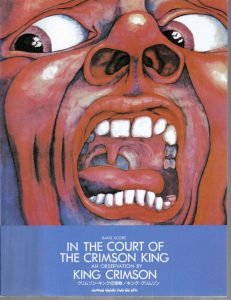
King Crimson
The fascinating history King Crimson began with the seminal trio Giles, Giles & Fripp in mid-1967 in Bournemouth, Dorset, England.
In 2019, Robert Fripp continues to lead the project, 50 years after the emblematic debut album, dozens of reincarnations involved, unforgettable albums and high-impact live shows.
This is the fascinating and intricate story of one of the most avant-garde, singular and influential chapters in rock history.
Best Sheet Music download from our Library.
The origins of King Crimson
In those days of relevant political, economic, social and philosophical changes, the Giles brothers were in the arduous search for a keyboardist/singer. Robert Fripp was, initially, the incongruous response to Peter Giles and Michael Giles ‘ classified . In its early days, the trio exhibited an interesting combination of musical genres tinged with sour humor that resulted in The Cheerful Insanity of Giles, Giles & Fripp (La Alegre Locura de Giles, Giles & Fripp).
Released in 1968, the album was an interesting work in which Peter Giles , vocals and electric bass; Michael Giles , drums; and Robert Fripp , guitar; They showed us, with remarkable mischief, a fusion of various currents such as pop, rock, jazz, folk and psychedelia.
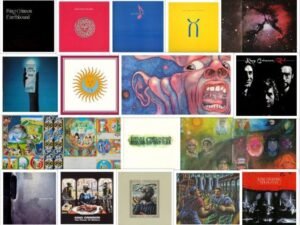
Prone to experimentation, the trio would soon become a quintet with the addition of Fairport Convention vocalist Judy Dyble and saxophonist, flutist and clarinetist Ian McDonald , later part of the duo McDonald and Giles , which would release in 1971 an album of the same name with a relatively successful song called “ Tomorrow’s People – Children of Today ”. Ian would also be a consubstantial element of the more commercial band Foreigner .
Songs like “ I Talk To The Wind ” and fragments of the piece “ Passages of Time ” would, in the next few years, be part of King Crimson’s extensive repertoire .
In 2001, Aluna Records released a second Giles, Giles & Fripp album , The Brondesbury Tapes , a 21-track album that also includes two versions of the beautiful era “ I Talk To The Wind pre-King Crimson” .
The schizoid man of the 21st century takes his first steps
In that second half of the 1960s, the European music scene was a melting pot, especially in England, where musicians changed groups with astonishing speed, giving rise to endless bands of unbeatable tenor. Everything was being invented.
Also in those tumultuous days, several musicians from the American free jazz scene took up residence there and in France. Already in 1968 the social movements for peace in Vietnam were accentuated in the United States and the racial protests intensified.
Artists like Sun Ra served as a vehicle for the poetry of the black leader Amirí Baraka and just a year before Miles Davis , who would record his iconic and influential Bitches Brew , knew Jimi Hendrix and Sly Stone , also spending time with a rock band during the days when the prestigious Down-Beat magazine declared that jazz, as we had known it, was dead.
Those were days in which Aretha Franklin demanded, with energetic passion, the most eloquent RESPECT.
Roughly speaking, everything was part of the context from which emerged that powerful and amazing musical force made up of Greg Lake ‘s horns and keys ‘s voice and bass, Ian McDonald ‘s drums , Michael Giles ‘s poetry , Peter Sinfield and the circumspect and sometimes neurotic guitar of Robert Fripp, who in a short time the world would collectively known as King Crimson and whose resounding success would be consolidated in England in London’s famous Hyde Park when they opened for The Rolling Stones in that now legendary concert held on the 5th July 1969, two days after the tragic death of Brian Jones.
They hadn’t released their debut album, but the songs already existed.
A telluric force of 9.9 on Richter
The power with which King Crimson ‘s first-born album hit the ears of budding and accomplished music lovers alike in 1969 overshadowed the initial offerings of today’s legendary bands like Yes and Genesis . The king and his court influenced and captured the attention of the music movement of the time, including immortal icons like Jimi Hendrix .
King Crimson ignited the deepest passions with their In The Court of the Crimson King LP , a terrific five-track album that began with the raucous, delirious “ 21st , Century Schizoid Man ” followed by the pastoral “ I Talk To The Wind .” ”, the gloomy “ Epitaph ”, the spatial and extensive “ Moon Child ” and the forceful title track, which meant a complete conceptual revolution and a distinguished beginning.
That deranged and intimidating face in red and blue that the LP cover exhibited, was the portal of a history of constant mutations that throughout nine albums in its first stage, would tell a host of fascinating stories that would go through more than one Ten musicians who would have their first stop along the way in 1975 with an attractive live album entitled USA and that at the end of one of the texts read the most lapidary of abbreviations, RIP (Rest In Peace) Rest in Peace!
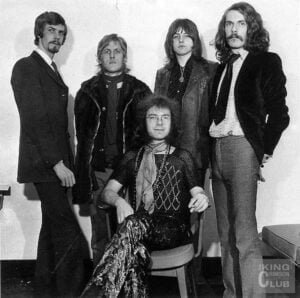
From tarot to the grave
After a start of such magnitude, there was the flavor of a long-awaited expectation that should be equal to or better than that of Barry Godber’s drawing (†). The tarot cards in In The Wake of Poseidon (1970) seemed to reflect a fateful omen.
Ian McDonald , Greg Lake (to form Emerson , Lake and Palmer) and Mike Giles left the band but, in the case of the second and third, not before participating in this excellent record work, to which the incredible pianist Keith Tippett joined , bassist Peter Giles (brother of Michael), saxophonist/flautist Mel Collins and vocalist Gordon Haskell , whom we can hear in his most sublime version on the beautiful “ Cadence and Cascade.
This second album, similar in format to the previous one, was a clear statement that was reflected in the headlines of the specialized press at the time and where there were quotes such as: “If Wagner were alive he would work with King Crimson” or this one that says “King Crimson alive and kicking” and one with a somewhat funereal tint that read “King Crimson, a bleak future”.
That same year King Crimson released Lizard (1970), their third studio album. The band introduced us to drummer Andy McCulloch replacing Michael Giles, and Haskell as bassist and official singer. The curious cover designed by Pete Sinfield with illustrations by Gini Barris invited us to delve into pictorial details with some characters and elements of the time.
It was the prelude to an increasingly daring music that still left room for sweetness, as in “ Lady of the Dancing Water ”, where the flute was as central as in “ I Talk To The Wind ” and “ Cadence and Cascade ”.
This time the LP brought us a group of special guests including cornetist Mark Charig , oboist Phil Miller , trombonist Nick Evans and again Keith Tippett on piano, the most special of all, without a doubt, being the participation vocalist Yes by Jon Anderson in the beautiful and complex suite that gives the album its name.
Consisting of “ Prince Rupert Awakes ,” where Anderson sang, “ Bolero: Peacock’s Tale ” and “ The Battle of Glass Tears ,” the work represents the influence of Impressionism intertwined with elements of jazz and rock.
This majestic composition, with its 23’15” duration, stands as the “ Close to the Edge ” (Yes), the “ Supper ‘s Ready ” (Genesis) or the “ A Plague of Lighthouse Keeper ” (Van Der Graaf ) of the monarch and his court.
King Crimson had never been so ambitious.
End of another stage of Crimson
After that golden triad, King Crimson would face another important change with the magical Islands released in 1971. A shrewd and reflective lyric with a greater accent on the experimental and jazz, was the result of the fourth LP.
Once again the monarch would change some of his subjects and introduce us to the histrionic voice of Boz Burrell and his appropriate bass along with the less orthodox drummer Ian Wallace to replace Haskell and McCulloch respectively.
King Crimson , with a more raw and “jazzed” sound, spoke to us about the “ Formentera Lady ” (Dama de Formentera) and the “ Ladies of the Road ” (Damas del Camino), immersing us in a hypnotic trance with the siren songs on “ Sailor’s Tale ” and stunning us with a disdainful, penetrating sound on “ The Letters ”, a track with a clear free jazz influence.
Fripp is sharp and stinging. Again we find Mel Collins behind the winds and once again the King introduces us to his guests, this time: Harry Miller on double bass, soprano Paulina Lucas on oboe , Robin Miller and cornetist Mark Charig .
The Fripp of those days declared with relative humility that he was “the lowest common denominator of the band” and that he also “dwelled where his head and his guitar were together”, which gave us an idea of the space that the King granted to the members of his rock court.
Although not without roughness, the King Crimson de Islands still left room for tenderness. This is how we appreciate in “ Prelude: Song Of The Gulls ” (Prelude: Song of the Gulls), where Fripp reiterates signs of his affection for the sonorities of classical music. One of the most prominent solos is Charig’s on the title track.
Earthbound (1972) was King Crimson ‘s first live album . It represented the departure of the poet Peter Sinfield , who had not only written the beautiful lyrics of the songs but participated in the sound and lighting and production of the King and his court, now a quartet made up of Burrell, Collins, Fripp and Wallace.
“Either it was Pete or it was me, but one of us had to go,” Fripp would say then. The LP presents five pieces recorded live with a very poor sound that decades later was substantially improved in relation to the original LP.
Despite this handicap, we can enjoy Collins in “ Peoria ” and the dislocated, interesting and extensive “ Groon ”, where the Crimson King gives full freedom to his subjects in a wild and purely organic performance. The fullness of free jazz a la King Crimson .
The title track is another instrumental download that starts with Wallace. Although the sound of this album is not optimal, even after its digital treatment, it captures the spirit of that ephemeral formation and the spontaneity of the time but with an avant-garde language.
Robert Fripp was at ease.
The total resizing of King Crimson
Following Islands and the tour that spawned Earthbound , Fripp was left on his own. A new incarnation, undoubtedly legendary, would take shape to conceive one of his masterpieces, Larks’ Tongues in Aspic , published on March 23, 1973.
King Crimson was now presented to us as a superlative quintet where David Cross on violin, John Wetton on vocals and bass, the famous Bill Bruford , who had just left Yes , on drums, Jamie Muir on percussion and the everlasting Robert Fripp on their black Custom Les Paul, they outlined a work full of diverse elements where improvisation, social chronicle, loneliness, sadness and sweetness wrapped in a sound that was often deafening and, on occasions, with abrupt changes and an enviable dynamic fit, that in moments travels from a controlled cacophony to the most beautiful verses, as we heard in the first part of the title track.
Then there’s the nostalgic “ Book of Saturday ” co-written by Palmer-James, Fripp and Wetton with a solitary reverse phrase emerging from Fripp’s hands and the delicate melody on Cross’s fingers.
We find another beautiful passage in “ Exiles ” with the violinist, once again, as the protagonist. The abrupt pause surprises us a bit but it doesn’t sacrifice the beauty of this song that throughout its 7’38” reminds us, somehow, of “ I Talk To The Wind ”.
A hilarious and ironic “ Easy Money ” opens space for Fripp, Bruford and Muir in an interesting dialogue between guitar and percussion.
The conclusion of a single period
The last triad of what we could call “the classic period” of this monarchy, is made up of Starless and Bible Black and Red , both from 1974 and USA from 1975.
The first of them is another magnificent record work where King Crimson exhibits its various influences more vigorously, but this time without Jamie Muir . The robust and overwhelming ” The Great Deceiver ” where Wetton tells us about some of the banalities of consumer society, opens this set of songs that continues with the dramatic ” Lament “, the melancholic ” The Night Watch ” and then the more organic “ We’ll Let You Know ” (We will let you know), whose development in crescendo and incidents slowly overlap until the end.
Another interesting moment is the composition “ Trio ” which, personally, represents the most beautiful moment of a discography that already has almost 50 titles. Closing this LP is the mysterious and lengthy “ Fracture ”.
Composed by Robert Fripp , the piece unfolds a melodic development with repetitive phrases that Fripp transforms throughout its 11’12”. Bruford accompanies him, adorning the phrases with a wide range of percussion instruments.
Violinist David Cross also breathes in other colors and textures as the piece gradually fills our hearing until it reaches a suspicious silence that is eventually destroyed by Fripp’s explosive guitars.
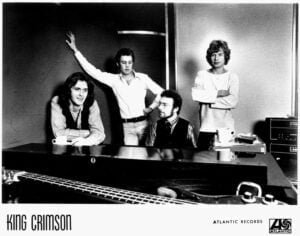
Red represents the peak of this stage of King Crimson , now a trio. Instrumentals built in a more structured way as in the title track up to the dramatic ” Fallen Angel “, passing through the telluric ” One More Red Nightmare ” (One more red nightmare) and the long but well-woven ” Starless “, Red revolves around to Bruford, Fripp and Wetton with the participation of Mel Collins , Marc Charig , Ian McDonald and Robin Miller on horns and David Cross on violin.
While the King and his court no longer had Sinfield’s poetry, Wetton’s less dense lyrics also struck the perfect balance between music and lyrics. Wetton was earthier and more realistic or perhaps less dreamy than the famed lyricist, but just as effective.
If history had been different, Red and its predecessor work would have had a more symphonic work in its successor, because although they sound a lot like the sour and corrosive sound of rock, we have no doubt that it was not enough to add the strings and increase the winds. .
Hungarian band After Crying give us a good idea with an excerpt from“ The Great Deceiver” live album Bootleg Symphony ” on their 2001.
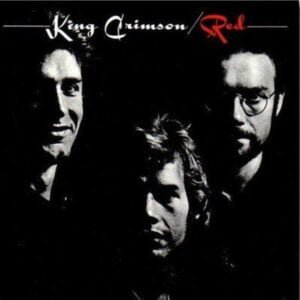
The last cry before punk
In the second half of the decade, the punk protest had already wreaked havoc. He managed to grab mass attention with a strident and urgent sound based on two or three chords, at least that’s how it was in the beginning. But that is another story.
The USA album represents for King Crimson the last album of the 70’s and the first hiatus of Robert Fripp ‘s transmuted band . Released in 1975, the LP includes the spontaneity of his live performance at Asbury Park, which is also the title of the only new piece on this lapidary album.
King Crimson , once again as a quartet with the inclusion of Cross on violin, sounded somewhat inconsistent. The new theme with Bruford redoubling at the beginning stimulated improvisation. Symbolically, the album concludes with the song that started this record label history, the explosive, deafening and maddening “ 21st Century Schizoid Man ”.
It is mandatory to point out that the Court of the Crimson King would publish in 1992 a box of four CDs called The Great Deciever that brings together songs from the period 1973-1974 live and where we can appreciate one of the cornerstones of the King Crimson sound , improvisation.
The Court, turned into a principality, reinvents itself while “the video killed the radio star”
The 80’s pushed many groups of the genre to create less dense, more accessible and shorter songs that would allow a commercial potential according to the times in order to gain their permanence in the market.
The year 1981 marked the beginning of the MTV era. The previous year, groups like Gentle Giant and the Genesis post Peter Gabriel , would not meet the expectations of a public that expected the continuity of works like Free Hand or Selling England by The Pound .
Instead, Civilian and Duke would be the record plates of those two bands, both somewhat disappointing. With Drama , Yes had perhaps saved their ’80s tenure despite an almost three-year absence.
While the “walkman” was redefining the way we listen to music, around the mid-1980s an attractive new format called the “compact disc” was beginning to gain sales. The “walkman” was already a collector’s item and the “disc man” would appear.
The King Crimson tricolor trilogy
Samplers, sequencers, programmed drums and a blurred line between black and white music characterized the 80s. And when MTV invaded the small screen with its videos, King Crimson , like the “phoenix”, was reborn from the ashes with an excellent trilogy : Discipline , Beat , and Three of a Perfect Pair , from the years 1981, 1982, and 1984, respectively.
They were the most stable years of the quartet made up of Adrián Belew on guitar, Bill Bruford on drums, Tony Levin on bass and stick and Robert Fripp on guitar, a new and fantastic reincarnation. KC thus guaranteed its permanence in a decade invaded by new wave and a new “British Invasion” that mostly left good memories.
Fripp’s experiences soloing ( Exposure and The League of Gentlemen project , being an example of his reinvention) and collaborating with David Bowie ; Levin’s records with Peter Gabriel ; and Belew’s fantastic internship with Talking Heads , decidedly influenced KC’s new sound.
Belew’s experimental guitar on ” Elephant Talk “, the percussive ” Sheltering Sky ” and the watery ” Matte Kudasai ” were the threshold of an King Crimson expansive, fresh and complex that still maintained part of its essence, as can be seen in the sound. of Fripp’s guitar, who from his alliances with Brian Eno would redefine his peculiar style developing “Frippertronics”, a sort of sound effect that resulted from a maneuver using a reel-to-reel recorder and an audio console.
Some eccentricities like “ Thela Hun Gin Jeet ” were always missing, which is more than an anagram or rearrangement of words, in this case, “heat in the jungle”. Much of this album partially includes personal anecdotes. The red cover with a Celtic symbol in the center reflects a minimalist feel that is repeated on the covers of the two subsequent albums.
On the Beat album , the quartet focuses on the generation of the same name, which represents the post-World War II literary movement that greatly influenced American culture during the 1950s.
All the themes are related in one way or another to said movement in celebration of the 25th anniversary of the book “ On The Road ” by Jack Kerouac , one of the most relevant characters of that movement.
The rejection of traditional values, sexual liberation, drugs and spirituality are some of the elements that are surreptitiously present in this musical creation, the ninth studio of the resurgent band.
The pulsating “ Waiting Man ” with Adrian and Bill at the center, the Frippertronics in “ Requiem ” and the disturbing “ Neurótica ” are some of the songs that stand out on this album. The cover is a musical note in pink on a blue background, thus maintaining a simple motif.
Three of a Perfect Pair ‘s tenth studio album , King Crimson , marked a return to combining free improvisational themes with more structured compositions. “ Sleepless ”, “ No Warning ”, “ Industry ” and the title track are three of the pieces of evidence that exemplify the above. Surprisingly we find a “ Larks’ Tongues In Aspic, part 3 ” a bittersweet “déjà vu”.
The yellow cover, with two curved figures one above the other, is the preamble to this latest album from the 80’s triad. King Crimson was still provocative, irreverent, bold, innovative and surprising.
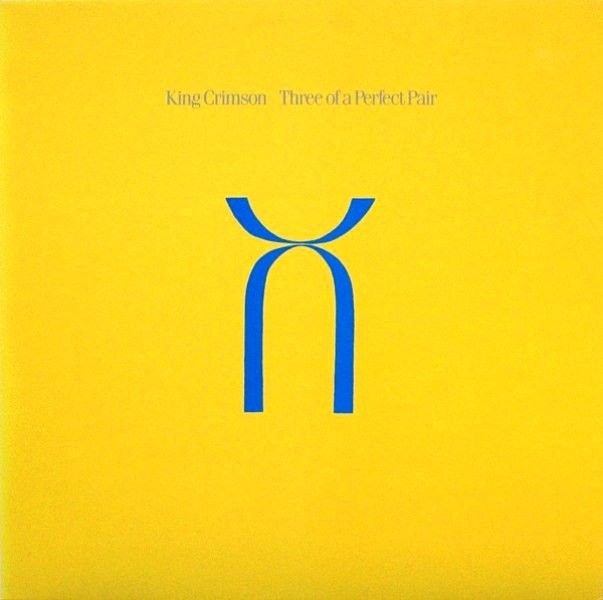
In this decade King Crimson exhibited an interest in music from Java and Bali (Indonesia) known as gamelan. Characterized by various percussion instruments, it has important visual evidence in the performance of Adrian Belew and Bill Bruford in the rhythmically provocative “ Waiting Man ”.
Sex, eat, drink, sleep and dream… King Crimson 10 years later!
Gone was acid jazz and trip hop and post rock were born, when in 1994 King Crimson welcomed us with a mini-album, as an appetizer, in a double trio format strangely called Vroom .
Hootie and the Blowfish , Nirvana , Alice in Chains and Soul Asylum were some of the alternative bands that were playing in those years. Grunge, hip-hop, eurodance and nu metal were some of the genres in vogue in the 90s. Britpop took up their influence.
But the King roamed other grounds, winning the immediate affection of his legion of fans who eagerly awaited a new reincarnation of King Crimson, while the band also gained a new audience. Thrak would be the “full length” album that King Crimson , now with the addition of Mr. Mister drummer Pat Mastelotto’s stick and guitar warr and Trey Gunn , released in 1995.
Six great musicians who injected the King Crimson of the 90s with the energy, weight, aggressiveness and innovation that many of us expected. Nothing sounded as raucous as this sextet, or double trio as Fripp called it.
Also in 1995 KC published B´Boom , the “official pirate” recorded live in Argentina with the repertoire of Vroom and Thrak . El Rey offered us a unique aural experience with the theme “ Vroom ”. Evoking a bit of Larks’ Tongues in Aspic , the piece has the King’s characteristic subtle twists and rough edges but with the addition of an element of mystery. 56’11” of stimulating music throughout the 15 compositions that make up the album, almost all of them with lyrics written by Adrián Belew.
All the pieces of the mini-album were here. The rhythmic “ People ” contrasting with a melodious “ One Time ” and a delirious “ Sex Sleep Eat Drink Dream ”. And of course, a ballad reminiscent of The Beatles could not be missing from “ Walking On Air ”.
The following year King Crimson released THRakaTTak , the most corrosive and free record work of the legendary group. It was the double trio in concert. King Crimson took improvisation to the extreme, alternating wide spaces with a greater interest in a more industrial and deafening texture.
The double triplet captivated us with a trio sounding on the right side while the other was heard on the left. It was like listening to Led Zeppelin taken to the most rusty, gritty, maddening level, delving into limitless spontaneity.
THRakaTTak leads us to think that King Crimson was a free jazz band with a brilliant and metallic sound where controlled cacophony prevailed or rather a kind of sound tunnel with moments that invite a brief reflection. Certainly a work conceived for unconventional ears in which King Crimson establishes new possibilities for new music.
Here those words of a headline that said “If Wagner were alive he would work with King Crimson” become valid.
The beginning of endless reissues
After THRakaTTak , King Crimson published a series of interesting works. The boxset titled The Projekcts , four CDs of some live performances where Robert Fripp , Trey Gunn , Pat Mastelotto , Adrian Belew , and Tony Levin alternated in trio and quartet formats; the double CD of Projekct Two : Space Groove and Vector Patrol , and the double live album entitled Cirkus: The Young Persons’ Guide To King Crimson , an excellent retrospective with the double trio performing some of the best of the 80s and 70s presented in two volumes which Fripp called Neon Heat Disease and Fractured .
It was the beginning of the endless and sometimes abusive recovery and dissemination of the entire legacy, including live recordings of doubtful quality and other fabulous ones that formed the King Crimson Collector’s Club collection launched exclusively by the newly created Discipline Global Music platform .
Building the light…
Although somewhat exhausted from hearing a repetitive formula, King Crimson triumphantly entered the new millennium with The Construkction of Light . The “mainstream” returned to the basic elements of “garage rock”.
The White Stripes , Kings of Leon , Coldplay , Incubus and Green Day were some of the bands that were leading the scene in the first half of the 2000s. It didn’t take much digging to understand that the Crims were far from that lot.
I cannot leave aside a fundamental fact: the influence of the web on the process and development of the genres and subgenres of popular music that had begun in the previous decade.
The world opened up in an abysmal way and we began to listen to the proposals of Nordic, Latin American and Asian groups in greater quantity. Two of them, Opeth and Nightwish . However, the British and Americans have continued to lead the market. At least that’s what it seems.
The Crims could now have a longer range. Adored in Japan, KC was, in those years, a quartet made up of Adrian Belew , Robert Fripp , Trey Gunn and Pat Mastelotto.
In eleven pieces broken down in 57’18”, KC still sounded attractive. The stoned “ Prozakc Blues ” with a histrionic Belew, the melodious title theme in its second version, the spacey “ Projekct X: Heaven and Earth ” and the mysterious “ Frakctured ” still bewitched us, even in titles as extravagant as “ The world is the kitchen floor wax museum of my oyster soup .”
A black cover with a blue frame and a weird image in the center didn’t say much, but something felt as cold as metal. One detail, perhaps irrelevant, is the repeated use of the initials kc in words such as fra kc tured, constru kc tion or proza kc . The contributions of Mastelotto and Gunn added a special seasoning to this variant, from that of 1974.
The last album formally recorded by KC is The Power To Believe (2003), even with Belew in it. In 2001, Level Five , a kind of sequel to The Construkction of Light (2002) was released the following year , was released, while the EP Happy With What You Have To Be Happy With , which heralded things to come.
During that period Belew was experimenting a bit with vocals, the song “ Bude ” being a good example. The Crims also composed songs with wide spaces as in “ Mie Gakure ” from the same album, a work focused on shorter compositions that did not exceed four minutes, including three of them less than one minute.
Larks’ Tongues in Aspic Part IV is the only one to go over ten minutes. KC was still alive in the new millennium.
The relationship between Andrew and Robert deteriorated and KC once again went into hibernation. ‘s official channels It’s not hard to conclude that Belew’s presence on King Crimson has been minimized and the inclusion of songs from the 80’s trilogy is minimal live, and there is little of the double trio stage.
Although each stage of KC has been different and is a reinvention, the voice, guitar and attitude of the North American is missed.
Membership of a schizoid club… plus!
One of Fripp’s most attractive ideas to keep the flame of the Crims alive was the creation of the DGM label. Robert Fripp was coming off a legal battle with EG Caroline Records.
The exhausting episode did not bear much fruit, so with a fairer proposal for the artists, the Crimson King created the aforementioned label through which it made available a series of live recordings only available on the Internet. The KC Club gave us that extra that every collector longs for.
During the years following The Power to Believe until the new reinvention in the following decade, the long list of Collector’s Club CDs became available. Nothing in the band’s history has been more rewarding for its fans than making live recorded Crims music available. More than twenty works increased the already extensive catalog of the group. In addition, several chests or box sets that delve into particular periods or albums have seen the light throughout this century.
The new resurrection of the Crimson Court
The Power To Believe closed an important musical cycle that committed the band to remain in the “top of mind”, not only of their devoted fans over almost four decades but also of new audiences.
King Crimson , synonymous with Beelzebub (prince of demons) and whose etymology is the anglicism of the Arabic word “bil sabab” whose meaning is “man with a cause”, seemed to have exhausted its creative source.
It would take eight years for the band to emerge once again from an apparent obscurantism with Scarcity of Miracles in 2011, a record work by King Crimson Projekct , a kind of rehearsal room for free improvisation derived from King Crimson whose idea was born from a suggestion that Bill Bruford did to Robert Fripp in the late 90’s . Frakctalisation of the Crimson King.
The album would mark a new beginning with the incursion of vocalist, guitarist and actor Michael “Jakko” Jakszyk , the return of legendary saxophonist and flute player Mel Collins and drummer Gavin Harrison of super band Porcupine Tree.
Tony Levin would remain in the Chapman stick and Fripp “the man with an aim”, as he himself would say, in the soundscapes and the guitar. Everything indicated that the best was yet to come.
From the elements to radical action…
And just when we thought the Crimson was dead, Fripp revives his court with an astonishingly daring lineup of three drummers: Gavin Harrison , Pat Mastelotto and Bill Rieflin ; Tony Levin on bass, Mel Collins on saxophone and flute, Jakko Jakszyk on vocals and guitar and finally our “King of the Hill” on guitar and soundscapes. Today Rieflin plays keyboards and his place as drummer is taken by Jeremy Stacey, becoming an octet.
Live at the Orpheum in 2015 and The Elements compilation series (one per year from 2014 to 2019) , retrospectively document the imposing and impeccable live sound of the current line-up , which could well be considered a rock band. academic.
All as a retrospective with versions of “schizoid”, “ I Talk To The Wind ”, “ Fracture ” and many classics from the 70s and more recent such as “ Scarcity of Miracles ” or even “ Tomorrow Never Knows ” by Lennon-McCartney, an unexpected touch.
To these should be added the most transcendental of all: Radical Actions to Unseat The Hold of Monkey Mind (2016).
The ambitious format renews the votes of the influential In The Court of the Crimson King , the enigmatic In The Wake of Poseidon , the poetic Islands , the iconic Larks’ Tongues In Aspic , the masterful Starless and Bible Black , the mature Red , the deafening Vroom and a punchy new track called “ Devil Dogs of Tessellation Row”.
It is enough to take a look at any of the videos or, better yet, attend one of the concerts, to finally understand that “ King Crimson is a way of doing things” and that “it only exists when there are musicians capable of performing such demanding music“, robust and complex that can go from the sacred to the profane, from sin to blessing or from heaven to hell, but always with the constant of the Crimson King, Robert Fripp , who recently declared that there will be no more studio albums and that all the creation will be on stage.
King Crimson – Easy Money
An excerpt from King Crimson’s forthcoming album – “Radical Action to Unseat the Hold of Monkey Mind” – a triple CD and BluRay set available from 3rd September. This is “Easy Money”, filmed in Takamatsu in Japan, featuring the combined talents of Mel Collins, Robert Fripp, Gavin Harrison, Jakko Jakszyk, Tony Levin, Pat Mastelotto and Bill Rieflin.
